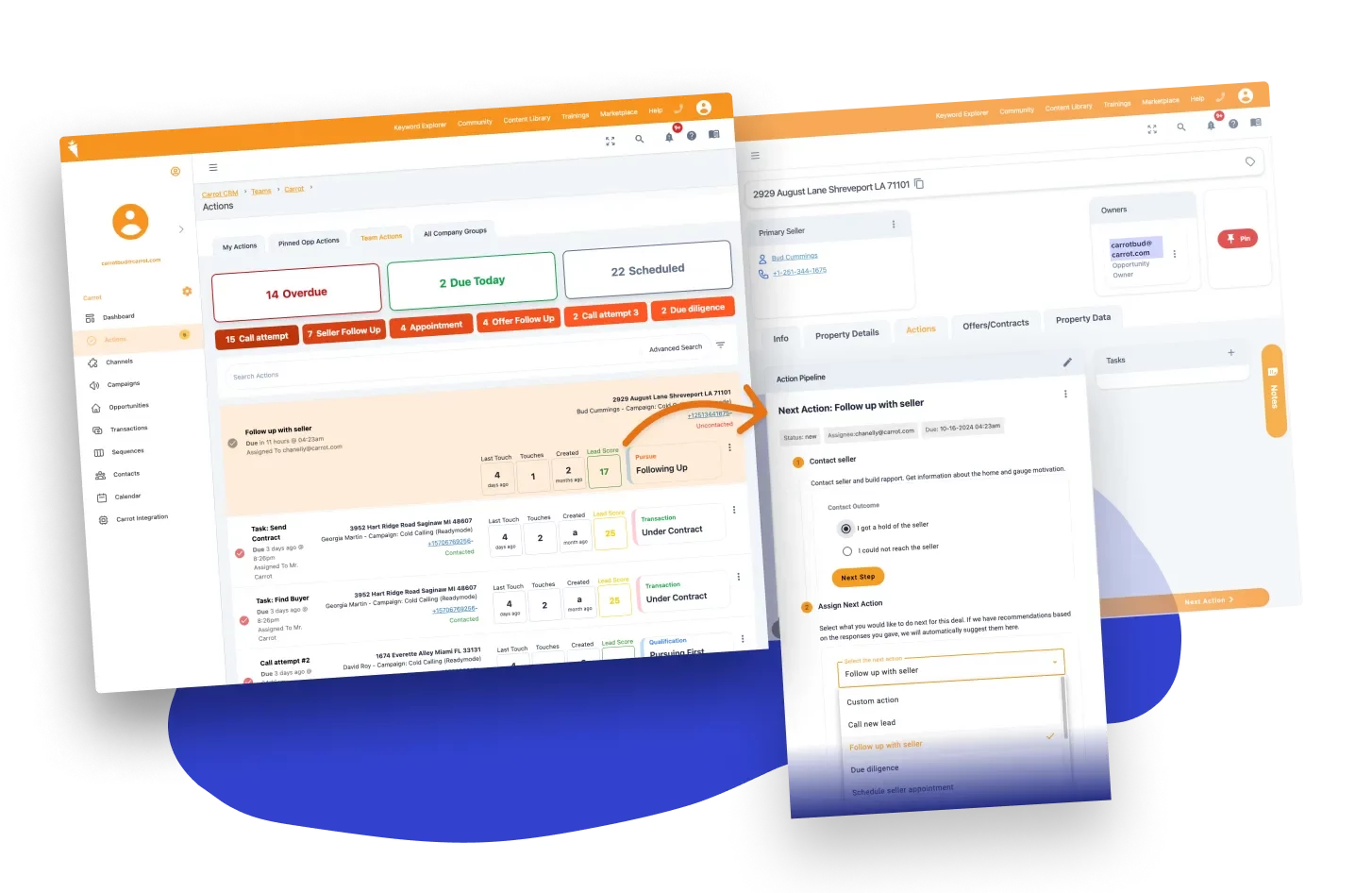We’ve talked about the path to freedom, flexibility, and consistency being available through Evergreen Marketing and SEO.
This is great for long-term strategy, but we also don’t want you to wait 6-12 months for leads to come in. We’re sure you don’t want that either. That’s why we suggest a mix of BOTH Evergreen Marketing plus PPC (Pay-Per-Click) Marketing.
So let’s dive into some PPC strategies to get quality leads coming in within the next 60 days that you can turn into closed deals. This is the same strategy we teach to all of our most successful members.
What is PPC Marketing?
PPC (Pay-Per-Click) Marketing is a form of online advertising where advertisers only pay when someone clicks on their ad. It’s one of the most effective ways to drive targeted traffic to your website.
Unlike traditional advertising (like print ads or billboards), PPC lets you control how much you spend, who sees your ads, and what kind of results you get. With Google Ads, you bid for keywords that potential clients might search for—meaning you’re showing up exactly when someone is actively looking for what you offer.
For example, if you’re a real estate investor looking for motivated sellers, you could bid on keywords like “sell house fast [your city name]” or “cash home buyers”. When someone searches for those terms, your ad will appear at the top of their Google search results, and you only pay when they click.
PPC gives you control over your marketing budget and lets you target specific audiences. Google Ads operates on a bidding system, meaning you can control your budget, set daily limits, and adjust your bids for specific keywords.
Google Ads also makes it easy to focus your marketing on specific geographic areas. You can target ads to specific cities, neighborhoods, or even zip codes, ensuring that you’re only reaching people in your desired location.
Get High-Quality Seller Leads Through Google Ads
We have lots of resources for getting started with PPC ads, including educational guides and trusted PPC & Facebook Ads providers (if you want to hire someone else to handle your PPC ads). So we’ve simplified what you need to know into 3 steps:
Step 1: Choose Your Carrot Landing Page
The landing page to choose will depend on your campaign strategy and your Carrot page structure. For most Carrot sites, you have two primary options: the Homepage, or by creating one of our pre-built Landing Pages optimized for a distraction-free experience while maintaining a high conversion rate.
Keep in mind, your Carrot site is designed with a “mini-site” strategy where the Homepage is also built like a landing page, specifically designed to also convert visitors to leads.
Selecting from a pre-built Landing Page has the benefit of fewer distractions (i.e., navigation) and condensed content to boost conversion.
Below is a cheat sheet of where we recommend you send your paid traffic.
Investors
- Motivated House/Land Sellers – Send to your motivated house seller Homepage, a distraction-free pre-built Landing Page, OR a Location Page for that specific location (ideally duplicated from your homepage after it has been made unique)
- Cash House/Land Buyers – Send to your cash house/land seller home page, create a distraction-free Landing Page, OR a Location Page for that specific location (ideally duplicated from your homepage after it has been made unique)
- Rent-to-own/owner-finance tenant buyers – Send to your home page or Landing Page as stated above.
Agents
- Retail House Buyers – Send to landing pages on your site (not the home page unless it’s modified to focus on one specific lead type w/ a form in the hero section). Buyer landing pages include Property Specific Landing pages, Niche List Landing Pages, etc.
- Retail House Sellers – Send to landing pages on your site, not the home page, unless it’s modified to focus on one specific lead type w/ a form in the hero section). Seller landing pages include the Home Value Landing page, etc.
IMPORTANT NOTE: For agents looking to convert more sellers to leads, the most effective way to convert highly motivated house sellers is through the “hybrid” model as an agent/investor. Learn more about the Hybrid Model by clicking this link.
ℹ️ Click here to learn how to build a high-converting PPC landing page →
Step 2: Set Up Your Google Ads Campaign
We have something we call the “60-Day Rule” here at Carrot. When we want to go into a market looking for motivated house sellers, most of the time, we’re able to pull out a deal and close it within 60 days. The way we do that is by launching Google ads while our Evergreen Marketing/SEO is growing. We start with Google because the leads tend to be much more motivated and ready to take action than leads through Facebook or many other sources.
We’ve found Google ads are best for highly motivated house sellers of houses and/or land. They can also work for other types of leads like buyers, tenants, land deals, etc.
If you’re a real estate agent looking for leads, we recommend starting with Facebook Ads. If you’re a real estate investor looking for motivated house sellers, start with our Google Ads primer training below.
ℹ️ Click here to learn how to launch a successful Google Ads campaign →
Step 3: Set Lead Cost & Volume Expectations
What will your average cost per lead be? Your average cost per lead is something that cannot be predicted before your campaign starts. It will depend on a variety of factors.
- Your market. The competition in your market will largely affect your average cost per click (CPC) and your conversion rate, which will affect your cost per lead. If you are in San Francisco, there is no way you can have the same cost per lead with the same quality leads as in Omaha, Nebraska. It doesn’t matter how well your campaign is run. If you have institutional investors or iBuyers in your market, that can also drive the price up. The only way to know for sure is to test a campaign for 60 days.
- The targeting and structure of your campaign. You can target very broad keywords, which may lead to a lower cost per lead, but also less quality leads. You may end up closing 1 in 20 versus 1 in 10. On the flip side, if you have a very compact and targeted campaign with a lot of high ad and landing page relevance, this will give you a good quality score and drive down the cost per lead. The cost increase can only be known through testing.
Remember, the average cost per lead is NOT an important question to be asking. Rather, it’s what the cost per DEAL is going to be. PPC leads can be much higher quality than direct mail, Facebook, and call/texting leads. You may close 1 in 5 leads versus 1 in 30.
So… what will your lead and deal volume be?
The right campaign can have a great Return On Investment (ROI) but still may not meet your deal volume expectations. This will be determined by:
- The budget that you set. Make sure to go through our “Setting Your Budget” section to create a realistic marketing budget that will help you succeed.
- Your average cost per lead. If you are in a higher-priced market like Denver, most major cities, or anywhere in California, your cost per lead will be high. The higher your lead cost, the fewer leads you will get for your budget. $1000 will get you more leads in Roseburg, OR than in San Francisco, CA.
- Your market. If your market has a population of under 500k, it will be difficult to spend more than a couple thousand dollars per month. If you are targeting a city in rural Montana and want to get three deals a month, it doesn’t matter if you are able to spend $10k per month; you won’t get three deals a month through PPC. You mathematically will not be able to spend that amount of money and target the number of visitors needed for a low-population town, therefore being unable to reach your target lead volume goals.
Troubleshooting Your PPC Campaign
Not seeing the results you hoped for with your PPC campaign? Check out these tips and mistakes to avoid:
If your PPC campaign isn’t producing the results you are expecting it to, take a look at these indicators in your account.
Click-Through Rate (CTR)
This should be 2-10+%. If you have a low click-through rate, consider restructuring your campaign and/or improving your ad copy. You will not spend your budget if you don’t get clicks on your ads.
Conversion Rate
Your conversion rate should be upwards of 10% for a strong PPC campaign with a Carrot landing page. If it’s not, consider adding credibility to your website to stand out from your competition. Also, review the quality of traffic in your Search Terms Report.
Close Rate
What % of leads are you closing? If you have gotten in 60 leads and 0 deals, maybe there is a gap in your acquisition process. How quickly are you responding to leads? What is your follow-up system like? This can also be impacted by the quality of leads, which is measured by the Search Terms Report.
Search Terms Report
Review this to measure the quality of your leads. The more motivated search terms you are paying for, the higher quality leads you will have. If you have a lot of “bad” search terms or “retail” leads that aren’t motivated, consider adding negative keywords or updating your account structure.
Negative Keywords
Don’t forget to add negative keywords to filter out irrelevant searches (e.g., “real estate jobs,” “real estate agents”). This will help ensure your ads aren’t shown to people who aren’t likely to convert.
Location Targeting
Are you targeting areas that don’t provide the best motivated seller leads for you? Consider updating your target locations to more “hot” areas.
ℹ️ Check out these steps to optimize your real estate investor PPC account →
Close More Deals
with Carrot CRM

Grow your revenue and turn more leads into closed
deals with Carrot’s built-in CRM.
Premium Support
& 1:1 Strategy Calls

Members with our Premium Support Add-On can book
a 1:1 video calls for tech questions & strategic advice.

